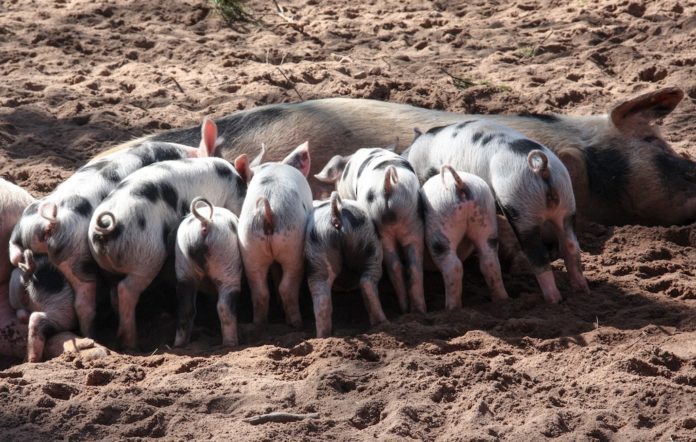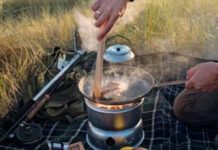Pigs are one of the best types of survival livestock a prepper can keep on his or her compound or bugout retreat. They are both easy and quiet keepers, require little space to house, can survive on low quality land, do not make much noise, and provide copious amounts of meat because you can eat almost every single square inch of the animal.
You can raise and butcher your own pork cheaper than you could buy the same amount of meat at the grocery store.
There are two types of pig breeds: bacon and lard. Prior to World War II, lard was in high demand. The lard from hogs (pigs and hogs are the same thing but are often referred to differently depending upon which part of the country you are from) was used for cooking, baking, cleaning firearms, candle making, soap making, and lubricating machinery.
Survival Sounder Facts, Pros, and Cons
• A herd of pigs of most often referred to as a sounder.
• Buying “weaners” or piglets, in the spring, will allow you to raise a hog to maturity by the fall.
• A weaner pig is a young pig that is less than three months old. The sow (a female pig that has given birth or fallowed) will wean her piglets by the time they are this old, hence the name, weaners.
• There is no need to winter over a hog unless it will be a breeder pig. Cows are almost always kept for two years before they are considered fully mature and at their prime butcher weight. Wintering over a cow is not cheap, nor will it be a simple task during a SHTF situation.
• The average sow produces a litter of about 10 piglets.
• Contrary to popular belief, hogs are actually really clean animals. They designate one area of their pen to use as a potty and bathe in their mud wallow daily to rid themselves of parasites and to stay cool in the summer.
• Pigs are primarily quiet animals, which makes them a superb livestock choice for preppers, but they are stinky – you will definitely know when you are downwind from a hog pen!
• Despite their large bodies, hogs are generally very easy to handle. Many pigs, with the exceptions or a lot of boars, are actually very friendly and affectionate creatures – which can make it difficult for some folks new to farming or homesteading to kill and butcher them.
• Hogs will help earn their keep by tilling the ground with their noses when searching for food. Allowing the hogs to roam inside growing areas may help prepare the soil for the next gardening season.
• Hog husbandry requires a lot less time and expense than is mandatory with other large livestock. It really does not take any more time to raise a pair of breeders than it does to cultivate a single hog.
• Pigs are one of the cheapest large livestock animals you can raise. They will forage for most of their own dietary needs and munch on any scraps that you throw their way – vastly reducing both the area which they need to roam and feed costs. You do not want you pigs in any large enclosure than is humane to keep them or risk the sounder running off too much of its weight.
• Butchering a hog is often deemed simpler and less time consuming than butchering a cow.
• A mature hog can weigh up to 600 pounds, depending on the breed. A hog of this bulk will typically give you a 250 pound butcher weight.
Related: How To Pickle Meat
Hog Meat
Pork loins, bacon, and sausage are perhaps the most commonly consumed and favorite parts of a pig, but you really can eat just about “everything but the squeal.”
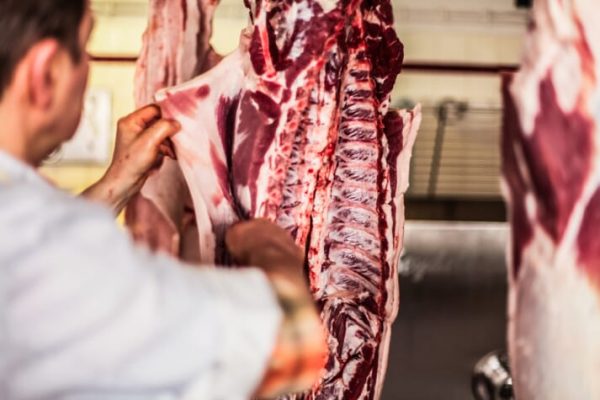

Tail – Leave a little bit of skin and fat on the tail, slather it with some butter and seasonings and fry it up in the skillet. The tail might not provide much more than a protein-rich snack, but it will be a delicious one!
Head – You can simmer the meat away from the hog’s head and use it to make shredded BBQ, as taco meat, or to make stuffed peppers. You can also remove the eyes, snout, and ears and then use a meat saw to split the pig’s skull and make head cheese.
Making head cheese is a lengthy process and involves salting the entire head and placing it in the fridge for at least two days. Next, the head is removed and rinsed thoroughly in cold water. The head is then simmered on medium to high heat – never coming to a boil, for about three hours.
The meat is then cut easily away from the skull and all the tiny bones are removed by hand. Cut up the meat into small pieces and simmer is on medium heat for approximately 20 more minutes. Stir nearly constantly to avoid scorching the head cheese and to remove the flat that will float to the top of the cook pot.
The head cheese is usually poured into a loaf pan and refrigerated until ready to use – or allowed to cool to room temperature and be eaten immediately like you would cold cuts. Head cheese can also be breaded and fried.
Hocks – Smoked pork hocks can be served as a snack or an entree for a casual protein-rich meal.
Pig’s Feet – You can BBQ the pig’s feet or pickle them, either way they little bit of extra meat will help fill the bellies of your love ones, quite deliciously, either pre or post, SHTF.
Tongue – Tongue does not either sound or look yummy – unless you disguise it to resemble a small roast of a meatloaf with potatoes, carrots, onions, and celery. In spite of its unusual look, hog tongue is actually quite good.
Related: How to Raise Your Own Meat
How to Make Tongue Loaf
To make a tongue loaf, put it in a pot with just enough water to cover it and bring to a rolling boil. Reduce the heat to medium and simmer the tongue, a little salt, pepper and your favorite spices for about three hours.
Next, drain the broth from the pot and serve the tongue loaf just like you would a roast. You can mix the broth in the pot with a little bit of flour and turn it into a gravy to spread over the tongue loaf/roast. Add a few sliced tomatoes and a ½ cup of brown sugar to the tongue loaf while it is simmering for a little bit of extra flavor.
Pig Breed Types Then and Now
There were two different types of pig breeds during the decades when the animals were still primarily raised on family farms and in the backyards of rural residents.
Bacon Pigs
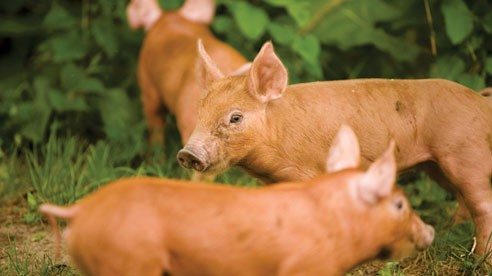

These breeds are both strong and muscular. Slow weight gain for this type of hog has long been the husbandry practice used by family farmers.
Their low energy and high protein diet routinely consists of dairy byproducts, grains, legumes, and turnips. A quality bacon pig would boast a body comprised almost exclusively of muscle and fat. The Yorkshire and Tamworth have long been among the most popular type of heritage breed bacon pigs.
Lard Pigs
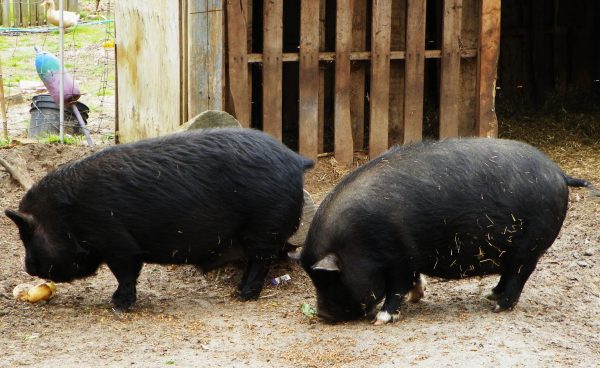

This type of hog has shorter legs than a bacon pig and has a more compact physique. The diet of a lard pig is based almost solely on corn. They fatten up more rapidly than bacon pigs.
The lard harvested from pigs of this breed type was used primarily for making explosives through the World War II era, for cooking and baking, and also as a machinery lubricant. If rendering lard is a common practice on your homestead, or you want it to be, harvest the “leaf lard,” or the white fat found near the pig’s kidney area. The leaf lard was once the most poplar type of lard used for baking in kitchens throughout the Midwest.
Related: Homesteads and Horses: What to Know
Top Hog Breeds for Preppers
1. Tamworths – This pig breed is extremely hardy, even in areas that suffer harsh winters or hot summers. Because their hair is a dark red shade, they are less likely to suffer sun scalding (pig version of a sunburn) than most other hog breeds. Sows of this breed tend to be excellent mommas and can provide enough milk to sustain even a large litter of piglets.
2. Saddlebacks – This hog breed is known to be excellent grazers. Saddleback sows often produce large litters and care for their offspring diligently.
3. Berkshire – Thee hogs generate top grade pork. The sows are known to be great milk producers even to large litters. Their dark black coat of hair helps protect them from sun scalding during summer months.
4. White Skinned – This breed grows extremely large and should provide a huge amount of meat for the prepping family. The only real drawback with it pertains to how susceptible the hogs are to sun scalding if raised in climates that have a hot and dry summer.
Building a Hog Pen
Shed Enclosure
Pigs can tolerate almost any type of climate, but must have protection from the elements – especially wet and drafty weather conditions. A simple wood shed with easy access flaps should provide enough protection for a hog to remain warm or cool, and dry. A metal shed is not recommended because it can maintain too much heat during the summer months. Construct flaps at the shed entrance so they can be tied back during the hottest months of the year to allow air flow to cool the inside.
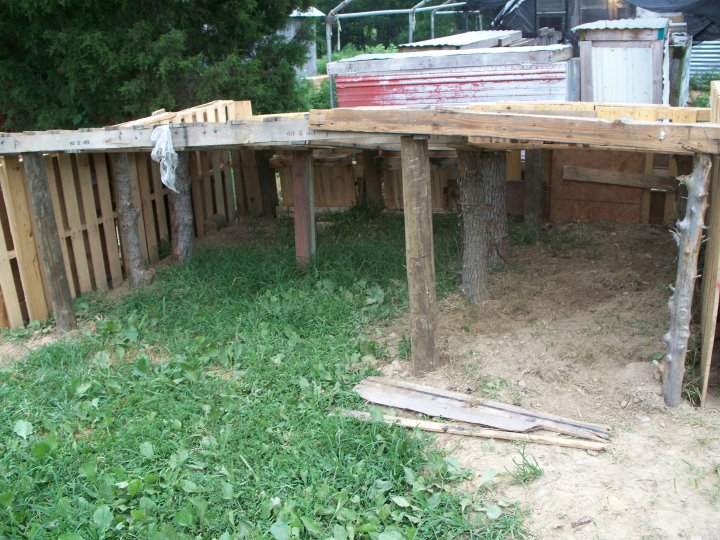

The dimension of the hog pen are dictated by how many animals are living inside. A hog shelter designed to house a boar and two breeding sows – and their eventual litters, should no smaller than four feet tall, 25 feet wide and 25 feet long.
A sow preparing to give birth will need a separate space to rest and then deliver and nurse her piglets. She will also need nesting materials, lie branches and straw, to complete her birthing and nursing area. The sow will hide her piglets inside the nest to protect them from possible attackers – including her now suspect and otherwise beloved caregivers. Be prepared for your typically pleasant sow to bite you hard on the shin if she thinks you are wandering too close to her piglets.
The hog pen must also include straw or similar livestock bedding material, a feeder, and a watering trough. The best hog feeders are one made, either commercially or in your workshop, that can be secured to a wall and have separators so each hog can put their head inside and eat a portion of the feed at the same time.
Hogs are prone to attempting to climb into their watering troughs during the summer months – often causing the water to tip over under their weight and harm them. A drip barrel waterer affixed to a post of wall, or a trough mounted inside a wood frame, should prevent the waterer from being tipped over.
Related: Pressure-Canning Hamburger Meat for Long Term Preservation
Fencing


Hogs can and will, constantly push against the fencing around their pen and try to push under it. Putting in proper fencing will be the most time consuming and expensive part of keeping hogs. Do this right, and keeping a sounder of pigs will be a lot less bothersome both now, and after the SHTF.
To ensure the hogs have enough grazing space to nearly feed themselves, fence in an area that allows about 50 square feet per pig. Disease can spread rapidly in a pen that is too small or too much manure is allowed to pile up in a small area. One of the many contagious that can afflict hogs and other livestock, could wipe our your living stockpile of protein in mere days.
Electric fencing is fine for horses, but it will not contain hogs. The best choices of material are pig panels, barbed wire, woven wire, attached to wood posts cemented into the ground and metal gates. If you pigs get out now, you will most likely be able to find them and get them back – do not expect such neighborly behavior if your hogs go walkabout during a doomsday disaster. They will likely be roasting on a spit long before you pick up their trail and track them down.
The fencing should be at least 26 if not 34, inches tall. Make sure to run a tight strand of wire just above the ground to prevent the hogs from burrowing out – add a line of electric fencing here to further deter, but not contain, the pigs. The wood pig pen posts should be set at a distance of no wider than 15 feet apart, for added durability.
Wallow
The mud wallow should not be situated near the potty area of the pen. Hogs will not get into the wallow to clean themselves if feces is lingering in the same area.
Hog Diet
Pigs can and will, eat almost everything that we do – kitchen scraps are often tossed into the hog pen to help fatten up the animals before butchering. A pregnant sow should have a little extra protein added to her diet before the litter is born. Oats are a great source of protein for both pregnant and lactating sows. Make sure not to give more than a 30 percent protein boost to the sow’s overall diet.
A young weaner should be consuming up to 18 percent of its diet from protein. When the piglet is about 12 weeks old, the protein content can be reduced to around 13 to 15 percent of the daily diet.
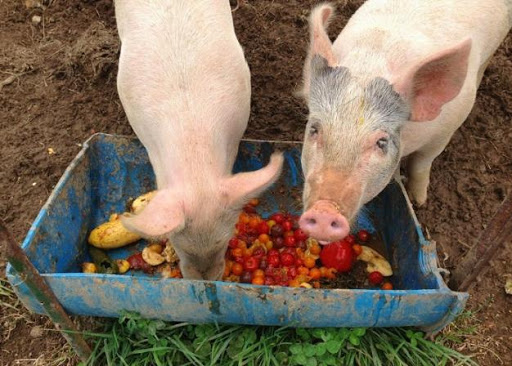

When a hog reaches maturity and weighs at least 75 pounds, it needs to consume about one pound of feed for every 25 to 30 pounds of its body weight on a daily basis. Hogs convert feed to meat by a ratio of approximately 3 to 1.
During the summer and the weeks of late spring and early fall when the daily temperature is at least 80 degrees, the feed to meat ratio decreases dramatically as the hog uses up a lot of calories to wallow and see out shade – meaning the animal will temporarily cease fattening up for butchering.
Scraps for Pigs
• Turnips
• Carrots
• Oats
• Silver Beats
• Barley
• Artichokes
• Wheat
• Comfrey – it’s high in B12 and will help keep the pigs healthy and putting on weight
• Corn
• Parsnips
• Sorghum
• Potatoes
• Cooked Meat
• Cooked Fish
• Meat Meal
• Watermelon
• Pumpkins
Related: 12 Best Rabbit Breeds for Raising Meat
Hog Butchering
Learning how to slaughter and butcher your own hogs will save you potentially hundreds of dollars per year now, while teaching a valuable skill that will be essential during a SHTF situation.
Slaughtering
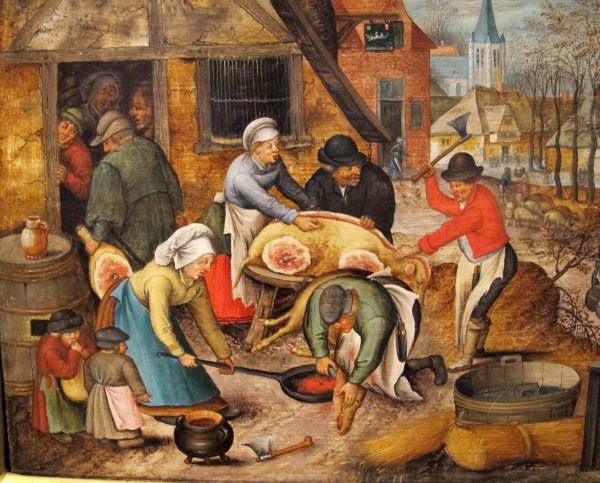

There are basically two common ways to butcher a hog that have not changed over the past 100 years: shooting the animal in the head with a .22 caliber rifle round, and slitting its throat.
When shooting a hog to put it down before butchering, place the barrel of the rifle only a little bit either left or right of the center of the hog’s skull, right above the animal’s eye. The hog will be brain dead after such a shot, and will not feel any pain after you slit its throat and wait about five minutes or so for it to bleed out. The hog will twitch, sometimes a lot, while bleeding out. A larger caliber round is not used because meat from the head and head cheese would be destroyed unnecessarily.
During a survival situation, you might not want to waste a single round of ammo or make an needless sounds. If you slice quickly through the hog’s jugular vein, it will die quickly, but not painlessly. The same bleeding out time period will occur.
Preparing for Butchering
There are also two common way to prepare a slaughtered hog for butchering: scalding and skinning. The goal is to remove both the hide and the skin from the hog. It is not necessary to remove all of the skin. Some folks believe removing only the hair and not the hide will allow the meat to keep longer and lock in moisture during cooking.
Scalding
To scald a slaughtered hog, dunk its carcass into a 55 gallon drum or large livestock tank that is filled with water that is heated by your chosen method, to at least 145 degrees. The pig carcass is soaked for only about three minutes before it is removed and the hair is removed with a scraper – typically a bell scraper tool designed for hog butchering.
Nearly all hog carcasses turn completely white during the scalding. The head and feet are usually the most difficult part of the carcass to scald, it is not unusual for a second scalding to be needed to enable the full removal of hair and the hide – if you so desire.
Related: How to Fish In An Emergency Situation
Skinning
Skinning a hog can be accomplished several ways, but this will give you a general overview of the process and the common order of operations.
1. Hang the hog on a meat hook in the survival compound’s butcher shop, or from a tractor blade that has been raised high enough to keep the animal off of the ground.
2. Make vertical cuts are on the rear leg just above the hooves.
1. Pull the leg tendon away from the body tissue and hang up to dry.
2. Make circular cuts above the hog’s hooves to allow the skin to be either cut or pulled away. If you know how to skin a deer, this process is conducted the same way, cutting back to front with a skinning knife.
3. Next, make a circular incision in the tail area to remove the hams. The hams are sawed out of the carcass with the butchering tool moving in a right angle from just behind the shank.
4. Now, cut all the skin away from the muscles.
5. Cut the hog all the way from its vent to its head – pulling down the bulk of the animal’s hide in the process.
6. Working in reverse from the way you skinned the back legs, skin the pig’s front legs.
7. Now, cut the head off of the carcass, making a cut across the animal’s neck just above the top of the backbone.
8. Remove the jawbone but leave the jowls in place. The jowl will be trimmed away carefully at the end of the skinning process so bacon squares can be made from the meat.
9. A meat saw is now used to cut the pelvic grid in half and to remove the guts from the pelvic area to the breastbone of the carcass.
10. Next, the entrails are very carefully cut from the carcass and pulled out to make sure the stomach does not pop and drop its content onto the remaining meat, effectively spoiling it.
11. Now the heart, liver, and gall bladder are cut out. Hand the heart and the liver out to dry by their narrowest points.
12. The intestines are cut out next, turned inside out, washed, scraped, and soaked for about 12 hours in a water and baking soda brine if they are going to be used as sausage casings.
13. The carcass of the hog is then washed in either cold or Luke warm water.
14. The backbone is then cut in half with a meat saw.
15. The carcass must now cool in a temperature no higher than 40 degrees, for a full 24 hours.
16. Once the carcass is cooled properly, the jowl can be removed.
17. Next the shank above the knee joint is removed.
18. Now the shoulder and butt are removed either in whole parts or divided, to can be cured. The fat from the butt is kept for lard rendering.
19. To make sausage, trim the tail bone loosely.
20. The most expensive meat cut on the hog, the tenderloin, is not cut out from the top of the backbone to the stomach. The rear tenderloin is trimmed to a quarter of an inch from the top of the back fat on the loin.
21. The belly area of the carcass is place onto the skinning table and all of its wrinkles smoothed out so the spare ribs can be cut away.
Hog Mating and Boars
Boars, in almost every incidence, will be the leader of the sounder. Unless you wind up with a small or young boar and a dominant, larger, and older sow, the boar will always be in charge of the pen.
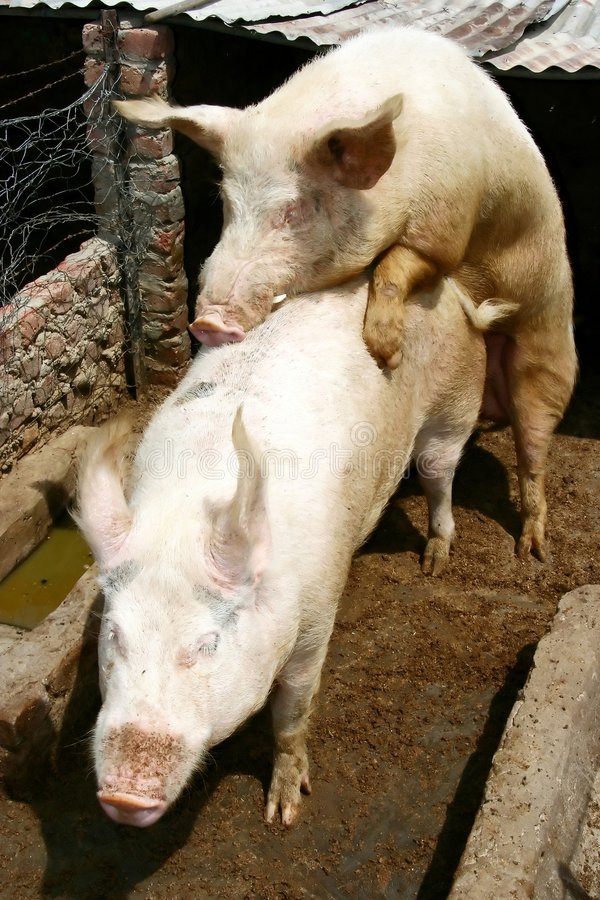

Choosing a boar wisely will play a large role in the future health and growth of the sounder. Ideally, you want to see the boar’s parents if they are onsite, or learn as much about them as possible from the breeder via photos and growth charts. These can be faked of course, so it still will remain a bit of a buyer beware situation – making the inspection of the boar, even if it is still a weaner, all that much more important.
• Look over the legs and the feet of the boar for any signs of lameness or weakness. A boar puts an immense amount of strain on his legs during mating. Walk the boar around and pay close attention to how easily he moves and watch for any signs of stiffness or the favoring of a let or foot.
• Review the toes of the pigs. They should not look either elongated or misshapen in any way.
• Having a boar with huge balls really isn’t a good thing. The testes should be similar in both size and shape and not be unusually small, thick, thin, or large. A boar’s sperm count is directly related to the width of his testes – a boar with narrow testes could have a weak sperm count.
• Typically, boars are more docile and easier to handle if they have had regular contact with other weaners and young sows until they are at least 30 weeks old – when it hits the puberty stage.
• Once the boar reaches puberty, it should be housed near the gilt (young female hog that has not yet mated) it will be mating with in an effort to facilitate courting behavior.
• A boar is not usually mature enough for mating until is hits puberty. Some boars will not successfully mate until they are one year old.
• One boar is capable of mating with up to 20 sows, but such high demand being placed on a boar often will cause harm to his legs and feet and lower the sperm count and small litters of piglets.
• If a boar is unable to mate with a gilt or sow during the first mating sessions because the female will not accept his advances or overpowers him, he may refuse to ever try again and resort to masturbating when sows near him come into heat – yes, fellow preppers, this really happens.
• Mating should occur in the morning when both large animals have not worn themselves out from roaming about all day and wallowing in the mud. Mating before they hogs have a full stomach usually reduces the strain on their lower body during the process.
• It often takes two mating sessions, that occur about 15 hours apart, to successfully impregnate a gilt or sow.
• During the mating session, the boar will often grunt at the sow and chase her if she runs. Once the sow stops, the boar will sniff all around her flank before attempting to mount her. The sow, if she accepts the boar, will then stand still, cock back her ears, and arch her back to help with the mounting maneuvers of the boar.
Related: Bushcraft Skills For Surviving in The Wild
Pig Health
Keeping the sounder healthy is always a top priority of all keepers. While you will be able to call a vet if an animal shows signs of illness, or shows no outward signs of sickness and suddenly drops dead now, you will not likely have that same luxury after the SHTF. These are the most frequent and deadly medical problems that can afflict a sounder, with many of them being deadly. Learn as much as you can about these conditions and natural ways to treat them – as well as when to know an animal needs to be put down and a pen disinfected or perhaps even burned down, while preparing to raise a sounder on your survival compound or bug in location.
1. Gastrointestinal Parasites
2. Sun Scalding
3. Atrophic Rhinitis
4. Winter Chill
5. Swine Dysentary – antibiotic necessary for the hog to survive
6. Photosensitization
7. Brucellosis – typically deadly with no known treatment
8. Sarcoptic Mange – quarantine and pen disinfection required
9. Lice
10. Hog Cholera – deadly, no known treatment
11. Lungworms – potentially deadly
12. Roundworms – potentially deadly
13. Whipworms – potentially deadly
14. Toxoplasmosis
15. Pork Measles – can spread to humans
Living in a sustainable manner as much as possible now, such as raising and growing our own grocery and apothecary, substantially enhances the chances of survival after the SHTF and during the rebuilding of society which will follow.
How to Render Animal Fat
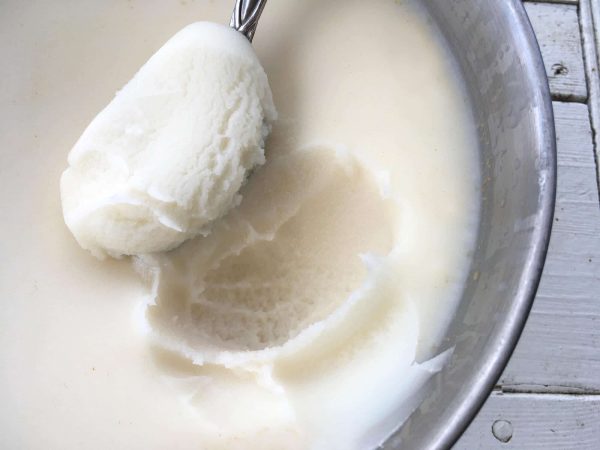

Rendering lard is not hard, tens of thousands of American homesteaders do it on a regular basis. Fat rendered from pigs is known as lard and fat rendered from beef livestock, is referred to as tallow. Lard and tallow can be used as base ingredients for biodiesel fuel.
1. Cut the lard or tallow into small chunks. Running the animal fat through a food processor or meat grinder will make this time consuming process go more quickly.
2. Put the lard chunks into a skillet to cook it down. Use only medium heat to avoid scorching the animal fat. Medium heat should range from 200 to 250 degrees.
3. Open a window or two if rendering lard indoors – it definitely does not produce a pleasant smell!
4. Stir the animal fat consistently to make sure it does not stick to the skillet while it enters a liquid state.
5. When the lard turns dark brown in color, a shade that is similar to cooked bacon, it is time to turn off the heat and remove the skillet from the stove.
6. Quickly, before the lard cools to room temperature and becomes almost solid again, pour it through a strainer and into Mason jars. Adding a layer of cheese cloth to the inside of the strainer will catch even more tiny particles.
7. Put a lid and ring on the Mason jar, vacuum seal it if possible, and then store in a cool dry place until ready to use.
Related: 25 Survival Uses For Leftover Bacon Grease
Pig Husbandry Facts and Tips
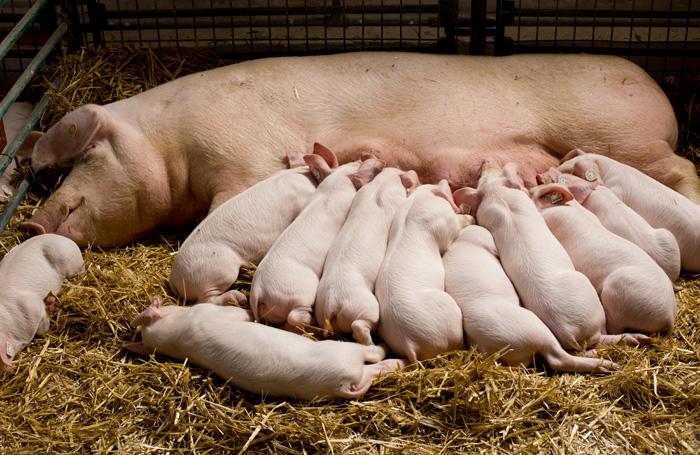

1. The average sow, a female cow that has put forth a litter of piglets, usually weighs about 350 pounds. A litter of piglets commonly consists of approximately 10 babies.
2. Pigs are usually deemed ready to butcher when they hit the 250 pound mark. In a factory farm setting, due to the diet and movement restrictions the hogs are raised under, this takes only about six months. On a traditional farm or homestead, reaching 250 pounds usually takes at least nine to 11 months.
3. Pigs are really and truly not messy animals. They root around in the soil of their pen and create a single spot to relieve themselves to keep their living area clean. Pig pens do smell, quite a lot, depending up the number of animals in the sounder. Locate their pen accordingly – keep it downwind from the homesteading residence.
4. Begin your introduction into raising hogs by purchasing a weaner. A weaner is a piglet that is no older than three months and has recently been weaned from its mother – a sow. The small pig will be easy to handle and will not intimidate a first time hog keeper who has little or no experience dealing with large livestock.
5. When a sow is entering active labor, she will make herself a nest out of leaves, branches, and other easily accessible material in and around her pen. The nest is really made to create a comfy place to give birth, but to built a secluded and fairly covered place to put the piglets to protect them from predators – of both the four and two legged variety.
6. Sows, no matter how nice they normally are, may not hesitate to bite you hard enough on the leg to bruise your skin or even draw blood, to keep you away from her litter.
• Adding more protein to the pig’s diet before butchering is also recommended. Both oats and barley are great sources of high fiber protein – but should only be given in small amounts, and incorporated into the routine feed cycle and not account for more than 30% of the diet.
• Corn and sorghum are also good to include in the hog’s diet.
• A hog reaches maturity when it weights approximately 75 pounds. A mature hog should be consuming roughly 1 pound of feed per every 25 pounds of body weight.
• During the summer, right before the fall butchering season, hogs stop fattening up temporarily due to the intense heat. They use up a lot of calories walking around to find shade and wallowing in their mud bath.
• You can increase the oat count in a sow’s diet while she is lactating, but reduce the intake once the litter is weaned.
• A piglet should be offered a diet that is comprised of 18% protein.
• When the young pig is about 12 weeks old, reduce the protein content of its diet down to around 13%.



